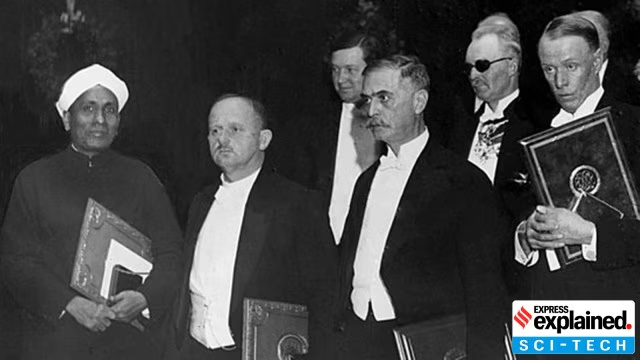National Science Day: What is Raman Effect, what are some of its uses
National Science Day 2025: Since when has February 28 been National Science Day? How did CV Raman make his great discovery for which he won the Nobel Prize, the only science Nobel for India so far?
 CV Raman with other Nobel Laureates in 1930. (Photo: Wikimedia Commons)
CV Raman with other Nobel Laureates in 1930. (Photo: Wikimedia Commons)National Science Day 2025: February 28 is marked as National Science Day in India. Unlike many commemorative days, this day is not the birth or death anniversary of a person, but the anniversary of a scientific discovery — on this day in 1928, Sir Chandrasekhara Venkata Raman discovered a new way light scatters. This was later known as the ‘Raman Effect’, and won him the Nobel Prize in Physics 1930. Till date, this remains the only science Nobel won by an Indian working in India.
What is the Raman Effect, and what are some of its applications? How did CV Raman discover it? We explain all this, and other interesting facts related to the discovery of the Raman Effect.
Since when has February 28 been National Science Day?
According to the National Council of Science Museums (NCSM), in 1986, the National Council for Science and Technology Communication asked the Government of India to designate February 28 as National Science Day.
The government accepted, and the first National Science Day was celebrated on February 28, 1987. “The basic objective of the observation of National Science Day is to spread the message of the importance of science and its application among the people,” the NCSM website says.
The theme of this year’s National Science Day is ‘Empowering Indian Youth for Global Leadership in Science & Innovation for Viksit Bharat.’
What is Raman Effect?
Put simply, when light strikes a material, it interacts with the materials’ molecules and exchanges energy. Now when this light is scattered by the material, a portion of the light is of a different wavelength, and thus of a different colour. An example of this — and the phenomenon that led Raman to his discovery — is the blue colour of oceans, which is the result of the scattering of sunlight by water molecules. Similarly, the blue of the sky is a result of the scattering of sunlight by air molecules.
How did Raman come about his discovery?
Raman was born in Trichy in 1888. He showed an early talent in science, receiving a BA degree from Presidency College in Madras at the age of 16. He eventually took up a job as an assistant accountant general in Calcutta, but continued scientific experiments. When he travelled to London in 1921, he already had a reputation as a great scientific mind, thanks to his work studying the vibrations and sounds of instruments like the veena, the tabla and the mridangam.
It was on his return trip from London to Bombay aboard the ship SS Narkunda that the striking blue colour of the Mediterranean Sea caught his attention, eventually leading to his great discovery.
The American Chemical Society (ACS) has described how Raman conducted his experiment, “The violet light of the solar spectrum is isolated with a violet filter and passed through the liquid sample. Most of the light emerging from the liquid sample is the same colour as the incident violet beam… However, Raman and KS Krishnan [his student] were able to show that some of the scattered light was a different colour, which they could isolate by using a green filter placed between the observer and the sample.”
Raman’s lab the year before had acquired a refracting telescope, using which Raman managed to condense sunlight to get a beam powerful enough for his experiments.
What are the applications of the Raman Effect?
If we can read how light is scattered by a substance, whether solid, liquid, or gaseous, we also get an idea about the structure of the substance, without breaking it apart for examination.
Once the use of lasers took off in the 1960s, the uses of the Raman Effect multiplied. As the ACS puts it, “Illegal drugs captured at a crime scene can be analysed rapidly without breaking the evidence seal on the plastic bag. Chemists can watch paint dry and understand what reactions are occurring as the paint hardens. Using a fiber-optic probe, they can analyse nuclear waste material from a safe distance.”
- 01
- 02
- 03
- 04
- 05






































